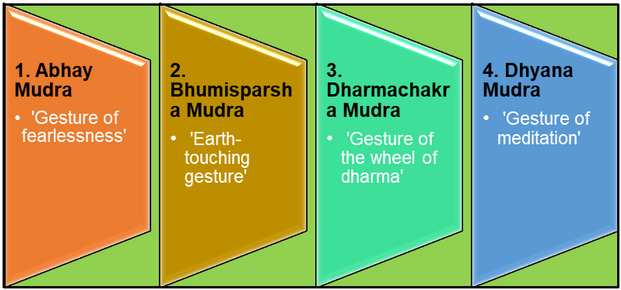News Excerpt:
Recently, India’s Leader of Opposition in Lok Sabha invoked the abhaya mudra, the gesture of the raised open palm that is commonly understood as conveying reassurance and a freedom from fear.
- He portrayed the current government as a regime based on fear, and stressed that the culture of fear is alien to the Hindu religion and Indian civilisation.

Mudras in Buddhism:
- In Sanskrit, the term mudra could mean a seal, mark, sign, or currency, but in the Buddhist context, it refers to “hand and arm gestures made during the course of ritual practice or depicted in images of buddhas, bodhisattvas, tantric deities, and other Buddhist images”.
- Mudras are most commonly associated with visual depictions of the Buddha (or Buddharupa), with different gestures conveying different moods and meanings, signifying the subtle manifestations of the Buddha’s states of realisation.
- The earliest depictions of the Buddha in physical form date to roughly around the turn of the first millennium.
- Depictions started appearing in the Gandhara art from the northwestern edge of the Indian subcontinent (present day Pakistan and Afghanistan), which drew on Hellenistic influences, and later in the art of the Gupta period, in the Gangetic plains.
- In the earliest depictions of Buddharupa, four mudras can be found:

- With the evolution of Mahayana (Greater Vehicle) and Vajrayana (Thunderbolt Vehicle) Buddhism, and the proliferation of Buddhist artwork outside India, hundreds of mudras entered Buddhist iconography.
- In tantric Buddhist traditions, the mudras came to be associated with dynamic ritual hand movements, where they “symbolised material offerings, enacted forms of worship, or signified relationships with visualised deities”.
Abhaya mudra in Hindu religion:
- Over time, the abhaya mudra appeared in depictions of Hindu deities, and the Buddha himself was absorbed into the Hindu pantheon as the ninth avatar of the Puranic god Vishnu.
- The first mention of the Buddha avatar came in the Vishnu Purana (400-500 CE).
- As multiple traditions, practices, and cultural influences mingled in the great melting pot of the Hindu religion, manifestations were seen in art and visual depiction of gods. The abhaya mudra was seen in the depictions, most commonly of Lord Shiva, Lord Vishnu, and Lord Ganesha.
Gesture of fearlessness:
- In Buddhist tradition, the abhaya mudra is associated with the Buddha immediately after he obtained Enlightenment, “portraying a sense of the security, serenity, and compassion that derive from enlightenment”.
- The “gesture of fearlessness also identifies the moment when Shakyamuni (the Buddha) tamed the mad elephant…illustrating the Buddha’s ability to grant fearlessness to his followers”.
- According to Buddhist legend, Devadatta, a cousin and a disciple of the Buddha, upon not being granted the special treatment he expected, plotted to harm the Enlightened One. He fed a wild elephant intoxicants and drove her on the Buddha’s path. As the disciples scattered before the charging animal, the Buddha raised his hand in the abhaya mudra of love and kindness. The elephant is said to have calmed down immediately, gone down on her knees, and bowed her head to the Buddha.
- This is why the abhaya mudra is also seen as a “gesture of protection” or “gesture of granting refuge”.


